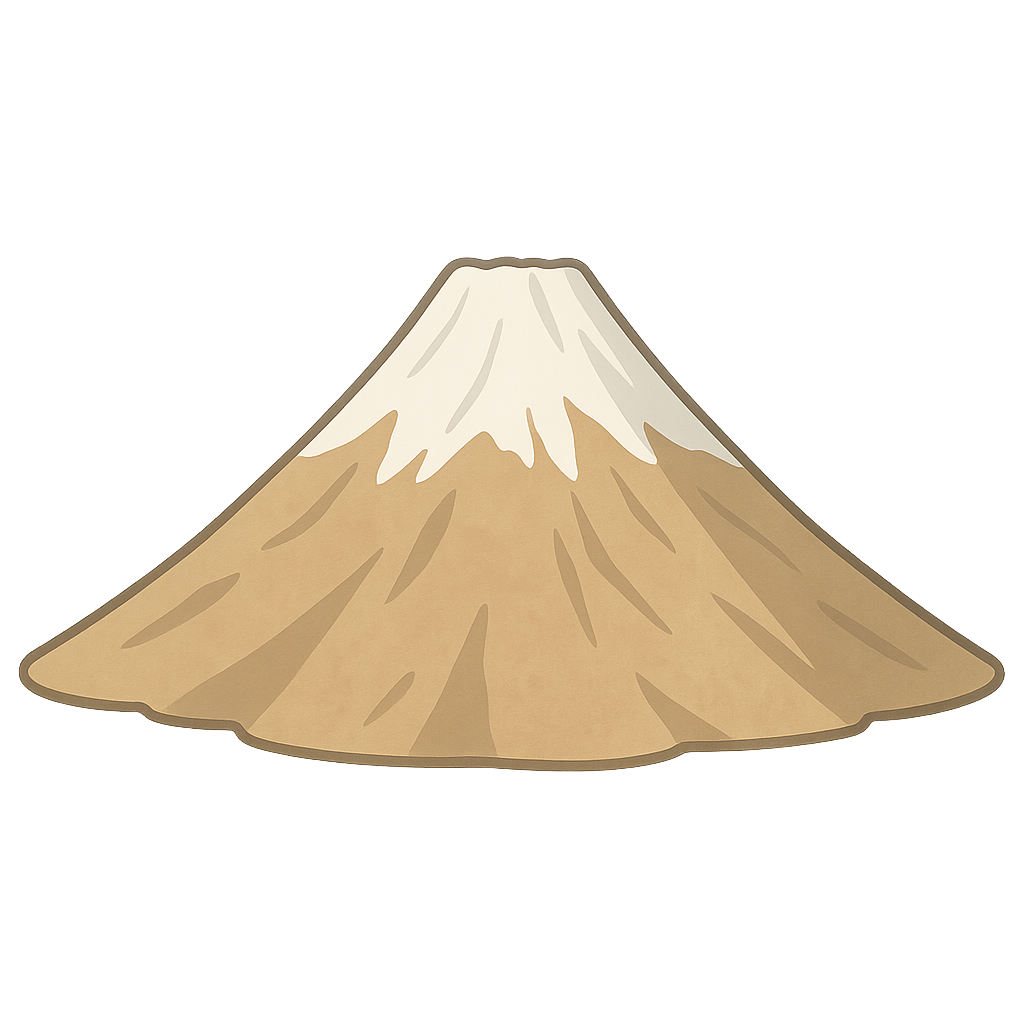The Story of Mount Fuji
From my highest point, I watch the world wake up. Before the sun appears, a sea of white clouds stretches below me, so thick and soft it looks like you could walk on it. Then, as dawn breaks, my rocky skin blushes, shifting from deep purple to fiery red. Far, far below, the lights of cities begin to fade as a new day begins for the country I watch over. I stand alone, a nearly perfect cone reaching for the sky, and for most of the year, I wear a brilliant cap of pure white snow. I am a quiet giant, a silent watcher who has seen emperors and artists, pilgrims and travelers, pass beneath my gaze for thousands of years. I have been painted, climbed, and worshipped. Have you guessed who I am? I am Fuji-san, Mount Fuji.
My story did not begin peacefully. I was born from fire and earth, a child of immense power. I am a volcano, but not just one. I am actually three mountains stacked on top of each other. Deep beneath my slopes sleep my ancient ancestors, the Komitake and Ko-Fuji volcanoes, who erupted long before I was born. Over hundreds of thousands of years, eruption after eruption added new layers of ash and lava, building me up, higher and higher, until I reached my present shape. People often think of eruptions as destructive, but mine were also acts of creation. My fiery breath and flowing rock reshaped the land around me, carving out five beautiful lakes that now shimmer at my feet like a string of jewels. My last great display of power was the Hōei eruption in the year 1707. It was a mighty event that covered the nearby city of Edo, now called Tokyo, in a fine layer of ash. But since that day, I have been quiet. For over three hundred years, I have rested, a sleeping giant, watching the world of humans change in ways I could never have imagined.
For as long as people have lived on the islands of Japan, they have looked up at me with a mix of fear and wonder. I was not just a mountain to them; I was a sacred place, a gateway to the heavens and the home of powerful spirits, or kami. They believed a beautiful goddess, Konohanasakuya-hime, the blossom-princess, lived at my summit, and they worshipped her to protect their villages from my fire and to ensure their crops would grow. Climbing me was not a sport; it was a profound spiritual journey. It was a way to purify the soul and connect with the divine. The first people who dared to climb my steep, rocky slopes were monks and pilgrims seeking enlightenment. Legend says that a monk named En no Gyōja was the first to reach my summit all the way back in 663 CE, guided by his deep faith. For centuries after, countless pilgrims dressed in simple white robes, representing purity, would make the difficult ascent. They chanted prayers as they walked, their straw sandals shuffling on the volcanic rock, believing that reaching my peak brought them closer to understanding the mysteries of life and the universe.
As time went on, my role began to change. I was still a sacred peak, but I also became a muse. I became a model for artists who wanted to capture my beauty for everyone to see. I have posed for countless paintings and poems, but none made me more famous than the artist Katsushika Hokusai. In the 1830s, he created a series of woodblock prints called 'Thirty-six Views of Mount Fuji.' He was fascinated by me and wanted to show me from every possible angle, in every season and mood. In one famous picture, I am small in the distance, perfectly framed by a giant, clawing wave about to crash over tiny fishing boats. In another, I am a deep, majestic red under the morning sun. He painted me standing proudly behind cherry blossoms in spring and cloaked in the quiet stillness of winter snow. These beautiful prints were not just admired in Japan. They traveled across the oceans to Europe and America, and for many people, Hokusai’s images were their first glimpse of Japan. Because of his art, my perfect cone shape became recognized all over the world, a timeless symbol of the beauty and spirit of an entire nation.
Today, my slopes are busier than ever. During the summer climbing season, from July to September, a new kind of pilgrim arrives. Thousands of people from Japan and every corner of the globe come not just for spiritual reasons, but for the challenge and the shared experience of reaching the top. Before dawn, if you look up at my trails, you can see their headlamps moving slowly upward, a winding river of light twinkling like fireflies in the dark. The joy they feel when they reach my summit and watch the sunrise together is a powerful thing to witness. In 2013, I was recognized as a UNESCO World Heritage site, not just for my natural beauty, but for the deep cultural and artistic inspiration I have provided for centuries. I am more than just rock and snow. I am a symbol of strength, endurance, and the beauty that connects nature and humanity. I will always be here, watching over the world and inspiring new dreams in all who look up at my peak.
Reading Comprehension Questions
Click to see answer
